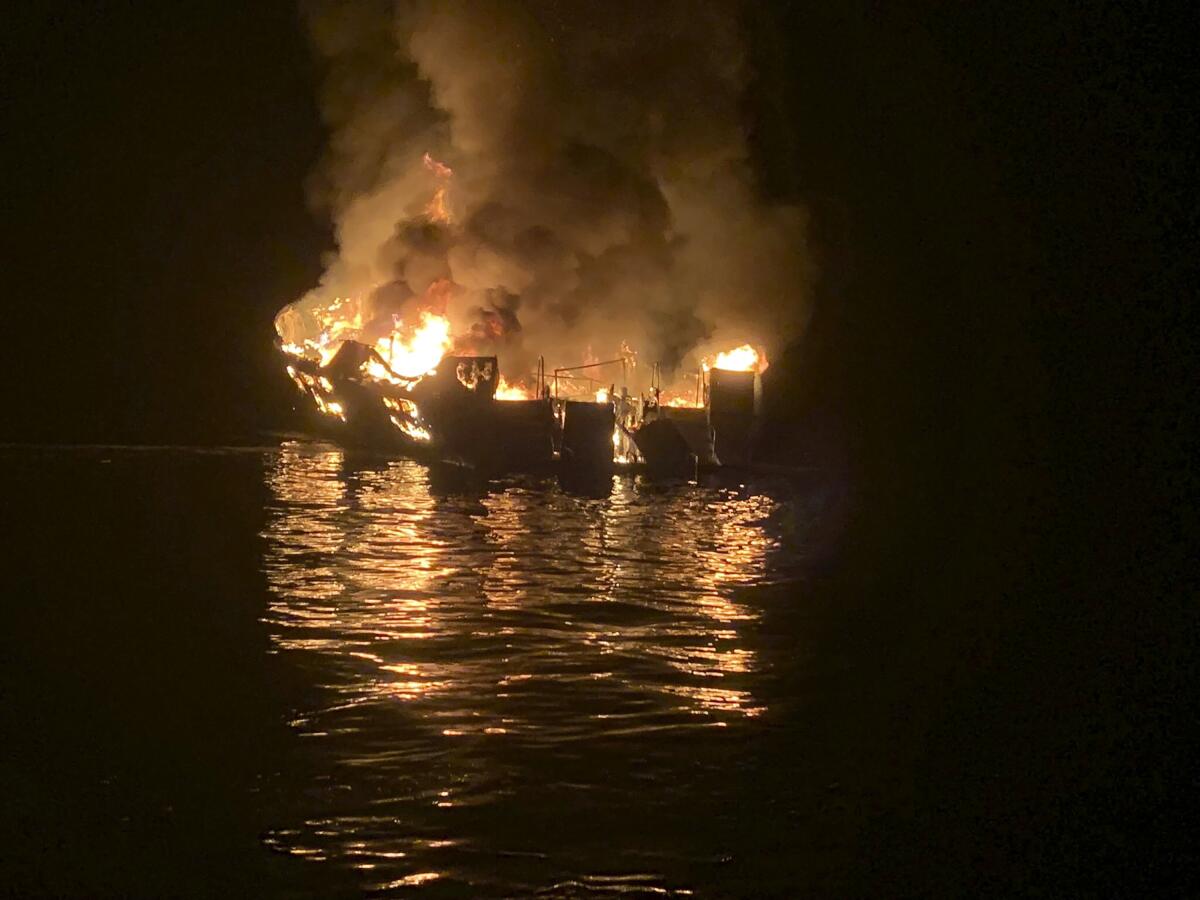Boat on which 34 died in fire was exempt from latest Coast Guard safety rules, records show

- Share via
The Conception dive boat, on which 34 people died in a Labor Day fire, had been exempted by the U.S. Coast Guard from stricter safety rules designed to make it easier for passengers to escape, documents and interviews by The Times show.
The Conception was one of about 325 small passenger vessels built before 1996 and given special exemptions from safety standards that the Coast Guard imposed on new vessels, some of which required larger escape hatches and illuminated exit signs, records show.
The rules require vessels to have an escape hatch of at least 32 inches wide and exit signs that are illuminated. The Conception, built in 1981, had an escape hatch that was only 24 inches wide, according to several federal regulators who requested anonymity in order to speak on the matter. It also did not have illuminated exit signs.
It’s unclear whether such measures would have made a difference on the Conception, on which passengers on a weekend diving expedition were trapped in the hull during an early morning fire and unable to escape. Crew members on the deck said they were unable to reach the passengers because of intense flames.
But federal officials investigating the worst maritime disaster in modern California history immediately zeroed in on the functionality of the two exits in the area where passengers slept in stacked bunks beneath the waterline. National Transportation Safety Board investigator Jennifer Homendy told The Times in September that she was “taken aback” by the small size of the emergency escape hatches, adding that she thought it would be difficult for passengers to exit during an emergency in the dark.
In the aftermath of the fire, the Coast Guard has stepped up inspections of similar boats across the country. Several boat owners have said that among the issues inspectors have raised is the size of escape hatches, fire protection systems and crew training in emergencies.
The Coast Guard is already under scrutiny in the wake of the Conception fire. Earlier this month, The Times reported that the Coast Guard had often ignored NTSB recommendations to improve fire-safety measures for nearly 20 years.
The safety exemptions the Conception and other boats received in the 1990s are raising new questions.
“I am deeply concerned about the fire and sinking of the Conception, and the so-called grandfathering of boats under older boat safety regulations,” Rep. Julia Brownley (D-Westlake Village) told The Times.
“I am eager to receive NTSB’s final report on this incident and NTSB’s recommendations for updating federal laws in this area to ensure the safety of passengers and vessel crews.”
Kyle McAvoy, a marine safety expert at Robson Forensic and former Coast Guard chief of the Office of Commercial Vessel Compliance Policy, said the grandfathering of older vessels often happens when meeting new regulations is economically unfeasible and impractical.
When adopting changes to the Subchapter T regulations in the 1990s, McAvoy said the Coast Guard wanted to ensure improvements and safety for new boats, but also had to address what to do with existing vessels. Before the new standards were adopted, the Coast Guard sought public comment and conducted feasibility studies.
Older vessels “may not be able to change what they have,” said McAvoy, who retired as a Coast Guard captain in 2016.
The Coast Guard has the authority to make immediate safety changes in the wake of incidents such as the deadly Conception fire, McAvoy said.
He said he is not surprised inspectors are already scouring vessels across the country and he noted that owners can always go beyond the minimum standards to ensure passenger safety, adding: “The Coast Guard regulations are the floor, not the ceiling.”
The original regulations, written in the late 1950s, required two means of escape, but did not specify minimum dimensions or say where the exits needed to be located.
Currently, the Subchapter T regulations govern about 5,000 vessels on U.S. waterways. Of those, about 325 still fall under the original rules.
The Coast Guard had made numerous minor revisions to the original regulations throughout the years, but they were not sufficient to keep abreast of the changes affecting the small passenger vessel fleet since the 1960s, according to Coast Guard records.
Prior to the Coast Guard updating regulations in 1996, the last major revision occurred in 1963, records show.
The reasons for updates included vessels getting larger and not keeping up with fire-prevention technologies. Another reason was significant casualties on waterways, including 87 fire deaths between 1981 and 1986, federal records show.
Among the incidents was a fire aboard a vessel on the Mississippi River that claimed three lives. The Coast Guard determined that a $200 vapor detector would have prevented the deaths. Additionally, 32% of all fires occurred on wood-hulled vessels. And during that period, 57% of all fires started in the machinery spaces aboard the boats.
After multiple casualty investigations, the NTSB and Coast Guard each agreed that new rules were needed “to prevent casualties or alleviate damages and injuries from future casualties,” Coast Guard records show. “The Coast Guard agrees with many of the investigation recommendations that have been made.”
The 1996 revision required a larger “means of escape” for passengers to flee during an emergency. It also said the two “means of escape must be widely separated and, if possible, at opposite ends or sides of the space to minimize the possibility of one incident blocking both escapes.”
The rule also said the means of escape must allow for the “easy movement of persons when wearing life jackets. There must be no protrusions in means of escape that could cause injury, ensnare clothing or damage life jackets.”
Additionally, the rule stated: “The minimum clear opening of a door or passageway used as a means of escape must not be less than” 32 inches in width and “illuminated exit signs are required and must be installed.”
Truth Aquatics owner Glen Fritzler has defended his crew members’ actions in trying to save the doomed passengers. On Thursday, he said he supports safety regulations.
“We have always followed Coast Guard regulations and whatever is required,” he said in a statement. “Our past inspections reflect our commitment.”
In the days after the fire during a weekend excursion in the Channel Islands, the NTSB, Coast Guard and federal agents toured the Vision — an 80-foot vessel similar to the Conception.
Both boats are owned by Truth Aquatics, which operates the fleet for diving and other excursions around the Channel Islands. The U.S. Coast Guard has said the Conception had passed all recent inspections.
Though slightly larger than the Conception, the Vision has a similar layout. Single and double bunks are stacked two and three high in the boat’s sleeping quarters below deck. A wooden staircase leads from the sleeping area up to the galley. Authorities say the exit on the Conception — along with an escape hatch that opens up near the dive deck on the boat — was probably blocked by fire.
Homendy toured the Vision with Coast Guard Capt. Jason Neubauer, who oversees the Marine Safety Board of Investigation. She said she and the investigators turned the lights off to see what it would have been like for the passengers trapped on the Conception.
Getting to the emergency hatch was difficult, she said, adding that they couldn’t find the light switches in the dark. The small hatch also was troubling, especially for larger people, she said.
“It was very difficult,” Homendy said about trying to exit the escape hatch. “I was taken aback by that.”
Industry experts and numerous vessel captains told The Times they expect the government to adopt stricter safety regulations as a result of the 34 deaths.
“It is clear that the regulations are in need of serious revision,” said a Los Angeles maritime lawyer who requested anonymity. “Whatever ‘means of escape’ is, it needs to actually work in an emergency for everyone on the vessel.”
After the fire on the Conception, investigators have cited some of the same deficiencies pointed out by the NTSB in other boat fires: lack of crew training and inadequate safety measures and maintenance.
A preliminary NTSB investigation found that the Conception had violated a requirement that it have a roving watch during the night, saying the five crew members who survived awoke to discover the flames. A Santa Barbara County coroner’s review determined the 34 killed died of smoke inhalation.
While discussing marine casualties during the House hearing on Nov. 14, Coast Guard Rear Adm. Richard Timme, assistant commandant for prevention policy, said vessel owners and crews are the first line of defense to protect passengers.
“Equally important, the vessel master and crew play an essential role and should be the first to recognize problems and take early corrective action,” he said. “The vessel owner is obligated to support the master and crew’s ability to maintain the vessel and operate it safely.”
The results of the NTSB investigation into the Conception boat fire are expected to be released in 2020. The Bureau of Alcohol, Tobacco, Firearms and Explosives is working with the Coast Guard and NTSB on determining a cause of the deadly blaze.
Coast Guard investigators along with the FBI have served search warrants on Truth Aquatics and its vessels as part of a criminal investigation. The evidence gathered along with dozens of interviews is being reviewed by federal prosecutors as part of the ongoing probe.
During a House Subcommittee on Coast Guard and Maritime Transportation hearing about passenger safety on Nov. 14, Rep. Salud Carbajal (D-Santa Barbara) asked a top Coast Guard official why the Conception operated under outdated safety regulations.
“It has been brought to my attention that Conception was operating under ‘old T’ safety requirements, meaning they were not following the most up-to-date safety rules,” Carbajal told Timme.
Small passenger vessels weighing less than 100 tons fall under Subchapter T of the Code of Federal Regulations for boats.
Timme called the regulations “valid construction standards today” and said many vessels currently operate under them without any issues.
But if a formal Marine Board of Investigation, the highest-level marine casualty investigation in the Coast Guard, finds that the old construction standards contributed to the Conception tragedy, changes could happen, Timme added.
“We will absolutely look at that,” he said.
Brian Curtis, the NTSB director of the Office of Marine Safety, told Carbajal the agency is scrutinizing the old and current standards to determine if each adequately addresses “means of escape and crew responsibilities” on small passenger vessels.
“We’re taking a close look at all these regulations,” Curtis said, “to make sure this doesn’t happen again.”
More to Read
Sign up for Essential California
The most important California stories and recommendations in your inbox every morning.
You may occasionally receive promotional content from the Los Angeles Times.












